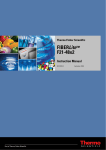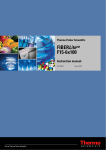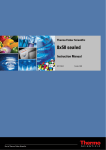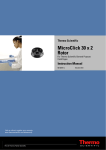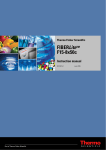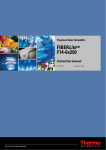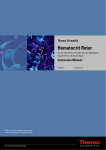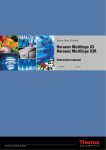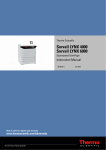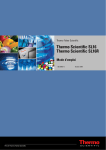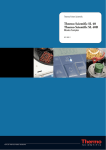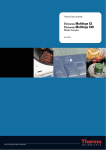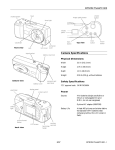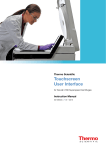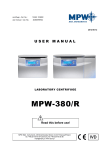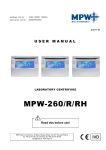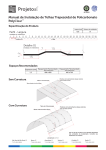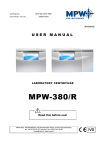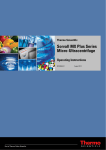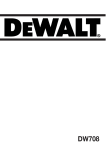Download Fiberlite F13-14x50cy Rotor User Manual
Transcript
Thermo Fisher Scientific FIBERLiteTM F13-14x50c Instruction Manual 50120007-2 August 2009 IMPORTANT! Please reference this page for the most up-to-date information on the following* • • web site addresses • contact information copyright and trademark information *All subsequent pages in this manual may have incorrect web site addresses and contact information. ©2013 Thermo Fisher Scientific Inc. All rights reserved. HERAEUS is a registered trademark of Heraeus Holding GmbH licensed to Thermo Fisher Scientific. Delrin, TEFLON, and Viton are registered trademarks of DuPont. Noryl is a registered trademark of SABIC. POLYCLEAR is a registered trademark of Hongye CO., Ltd. Hypaque is a registered trademark of Amersham Health As. RULON A and Tygon are registered trademarks of Saint-Gobain Performance Plastics. Alconox is a registered trademark of Alconox. Ficoll is a registered trademark of GE Healthcare. Haemo-Sol is a registered trademark of Haemo-Sol. Triton X-100 is a registered trademark of Sigma-Aldrich Co. LLC. All other trademarks are the property of Thermo Fisher Scientific Inc. and its subsidiaries. Manufacturer: Thermo Fisher Scientific Robert-Bosch-Straße 1 D - 63505 Langenselbold Germany Thermo Fisher Scientific Inc. provides this document to its customers with a product purchase to use in the product operation. This document is copyright protected and any reproduction of the whole or any part of this document is strictly prohibited, except with the written authorization of Thermo Fisher Scientific Inc. The contents of this document are subject to change without notice. All technical information in this document is for reference purposes only. System configurations and specifications in this document supersede all previous information received by the purchaser. Thermo Fisher Scientific Inc. makes no representations that this document is complete, accurate or error-free and assumes no responsibility and will not be liable for any errors, omissions, damage or loss that might result from any use of this document, even if the information in the document is followed properly. This document is not part of any sales contract between Thermo Fisher Scientific Inc. and a purchaser. This document shall in no way govern or modify any Terms and Conditions of Sale, which Terms and Conditions of Sale shall govern all conflicting information between the two documents T Table of Contents Preface .......................................................................................................................................iii Scope of Supply ........................................................................................................................iii Precautions ...............................................................................................................................iii Thermo Scientific Chapter 1 Rotor Specifications ..............................................................................................................1-1 Heraeus ....................................................................................................................1-2 230V 50Hz/60Hz ventilated ................................................................................1-2 230V 50Hz/60Hz refrigerated ..............................................................................1-2 120V 60Hz ventilated ..........................................................................................1-3 120V 60Hz refrigerated ........................................................................................1-3 Sorvall ......................................................................................................................1-4 230V 50Hz/60Hz ventilated ................................................................................1-4 230V 50Hz/60Hz refrigerated ..............................................................................1-4 120V 60Hz ventilated ..........................................................................................1-5 120V 60Hz refrigerated ........................................................................................1-5 100V 50Hz/60Hz ventilated ................................................................................1-6 100V 50Hz/60Hz refrigerated ..............................................................................1-6 Chapter 2 Accessories .............................................................................................................................2-1 Chapter 3 AutoLockTM .............................................................................................................................3-1 Rotor Installation .....................................................................................................3-2 Removing the Rotor .................................................................................................3-3 Chapter 4 Rotor Loading ..........................................................................................................................4-1 Before Run ...............................................................................................................4-2 Proper Loading .........................................................................................................4-2 Improper Loading ....................................................................................................4-3 Maximum Loading ...................................................................................................4-3 Chapter 5 Aerosol-tight Applications ...................................................................................................5-1 Basic Principles .........................................................................................................5-2 Fill Level ...................................................................................................................5-2 Checking the Aerosol-Tightness ...............................................................................5-2 Chapter 6 Maintenance and Care ..........................................................................................................6-1 Cleaning Intervalls ....................................................................................................6-2 Cleaning ...................................................................................................................6-2 Disinfection ..............................................................................................................6-3 Decontamination .....................................................................................................6-4 Autoclaving ..............................................................................................................6-5 75003661 F13-14x50c i Contents Service of Thermo Fisher Scientific .......................................................................... 6-5 RCF-Values ...............................................................................................................A-1 Chemical Compatibility Chart ...............................................................................B-1 Warranty and recommended Service Life .........................................................C-1 Contact Information ................................................................................................D-1 ii 75003661 F13-14x50c Thermo Scientific P Preface Before starting to use the rotor, read through these instruction manual carefully and follow the instructions. The information contained in these instruction manuals is the property of Thermo Fisher Scientific; it is forbidden to copy or pass on this information without explicit approval. Failure to follow the instructions and safety information in this instruction manual will result in the expiration of the seller’s warranty. Scope of Supply Article Number Quantity TM 75003661 FIBERLite 76003500 Rubber seal grease 1 70009824 Anti-corrosion oil 1 50120007 Instruction Manual 1 F13-14x50c Check 1 If any parts are missing, please contact the nearest Thermo Fisher Scientific representative. Precautions In order to ensure safe operation of the FIBERLite TM F13-14x50c, the following general safety regulations must be followed: • Do not remove the magnet at the rotor bottom • Do not use rotors which show any signs of corrosion and/or cracks. • Use only with rotors that have been loaded properly. • Never overload the rotor. Thermo Scientific 75003661 F13-14x50c iii Preface • Use only accessories which have been approved by Thermo Fisher Scientific. Exceptions to this rule are commercially available glass or plastic centrifuge tubes, provided they have been approved for the speed or the RCF value of the rotor. • Please observe the safety instructions. Please pay particular attention to the following aspects: • Rotor installation: Check that the rotor is locked properly into place before operating the centrifuge. • Always balance the samples. gMaximum sample density at maximum speed: 1,2----- ml This symbol refers to general hazards. ATTENTION means that material damage could occur. WARNING means that injuries or material damage or contamination could occur. This symbol refers to biological hazards. Observe the information contained in the instruction manual to keep yourself and your environment safe. iv 75003661 F13-14x50c Thermo Scientific 1 Rotor Specifications Contents • “Heraeus” on page 1-2 • “Sorvall” on page 1-4 Thermo Scientific 75003661 F13-14x50c 1-1 1 Rotor Specifications Heraeus Heraeus Table 1-1.230V 50Hz/60Hz ventilated Centrifuge Heraeus Multifuge X3 Heraeus Multifuge X3F Heraeus Multifuge X1 Catalog # 75004500 75004530 75004210 Weight empty [kg] of rotor 7.16 7.16 7.16 Maximum permissible load [g] 14x75 14x75 14x75 maximum speed nmax [rpm] 10,000 10,000 8,500 maximum RCF value at nmax 17,105 17,105 12,359 max. / min. radius [cm] 8.3 /15.3 8.3 /15.3 8.3 /15.3 Pitch angle [°] 34 34 34 Accel. / braking time [s] 135 / 90 135 / 90 95 / 90 sample heating at nmax [° C] referred to ambient temperature of 23 °C, running time 60 minutes 21 21 19 aerosol-tight no no no max temperature for autoclaving °C 121 121 121 Table 1-2. 230V 50Hz/60Hz refrigerated Centrifuge Heraeus Multifuge X3R Heraeus Multifuge X3FR Heraeus Multifuge X1R Catalog # 75004515 75004536 75004250 Weight empty [kg] of rotor 7.16 7.16 7.16 Maximum permissible load [g] 14x75 14x75 14x75 maximum speed nmax [rpm] 10,000 10,000 8,500 maximum RCF value at nmax 17,105 17,105 12,359 max. / min. radius [cm] 8.3 /15.3 8.3 /15.3 8.3 /15.3 Pitch angle [°] 34 34 34 Accel. / braking time [s] 115 / 90 115 / 90 95 / 90 aerosol-tight no no no max temperature for autoclaving °C 121 121 121 1-2 75003661 F13-14x50c Thermo Scientific 1 Rotor Specifications Heraeus Table 1-3.120V 60Hz ventilated Centrifuge Heraeus Multifuge X3 Heraeus Multifuge X3F Heraeus Multifuge X1 Catalog # 75004501 75004531 75004211 Weight empty [kg] of rotor 7.16 7.16 7.16 Maximum permissible load [g] 14x75 14x75 14x75 maximum speed nmax [rpm] 9,250 9,250 8,500 maximum RCF value at nmax 14,636 14,636 12,359 max. / min. radius [cm] 8.3 /15.3 8.3 /15.3 8.3 /15.3 Pitch angle [°] 34 34 34 Accel. / braking time [s] 145 / 90 145 / 90 120 / 105 sample heating at nmax [° C] referred to ambient temperature of 23 °C, running time 60 minutes 19 19 21 aerosol-tight no no no max temperature for autoclaving °C 121 121 121 Table 1-4. 120V 60Hz refrigerated Centrifuge Heraeus Multifuge X3R Heraeus Multifuge X3FR Heraeus Multifuge X1R Catalog # 75004516 75004537 75004251 Weight empty [kg] of rotor 7.16 7.16 7.16 Maximum permissible load [g] 14x75 14x75 14x75 maximum speed nmax [rpm] 9,250 9,250 8,500 maximum RCF value at nmax 14,636 14,636 12,359 max. / min. radius [cm] 8.3 /15.3 8.3 /15.3 8.3 /15.3 Pitch angle [°] 34 34 34 Accel. / braking time [s] 135 / 90 135 / 90 115 / 105 aerosol-tight no no no max temperature for autoclaving °C 121 121 121 Thermo Scientific 75003661 F13-14x50c 1-3 1 Rotor Specifications Sorvall Sorvall Table 1-5.230V 50Hz/60Hz ventilated Centrifuge Sorvall Legend XT Sorvall Legend XF Sorvall Legend X1 Catalog # 75004505 75004532 75004220 Weight empty [kg] of rotor 7.16 7.16 7.16 Maximum permissible load [g] 14x75 14x75 14x75 maximum speed nmax [rpm] 10,000 10,000 8,500 maximum RCF value at nmax 17,105 17,105 12,359 max. / min. radius [cm] 8.3 /15.3 8.3 /15.3 8.3 /15.3 Pitch angle [°] 34 34 34 Accel. / braking time [s] 135 / 90 135 / 90 95 / 90 sample heating at nmax [° C] referred to ambient temperature of 23 °C, running time 60 minutes 21 21 19 aerosol-tight no no no max temperature for autoclaving °C 121 121 121 Table 1-6. 230V 50Hz/60Hz refrigerated Centrifuge Sorvall Legend XTR Sorvall Legend XFR Sorvall Legend X1R Catalog # 75004520 75004538 75004260 Weight empty [kg] of rotor 7.16 7.16 7.16 Maximum permissible load [g] 14x75 14x75 14x75 maximum speed nmax [rpm] 10,000 10,000 8,500 maximum RCF value at nmax 17,105 17,105 12,359 max. / min. radius [cm] 8.3 /15.3 8.3 /15.3 8.3 /15.3 Pitch angle [°] 34 34 34 Accel. / braking time [s] 115 / 90 115 / 90 95 / 90 aerosol-tight no no no max temperature for autoclaving °C 121 121 121 1-4 75003661 F13-14x50c Thermo Scientific 1 Rotor Specifications Sorvall Table 1-7.120V 60Hz ventilated Centrifuge Sorvall Legend XT Sorvall Legend XF Sorvall Legend X1 Catalog # 75004506 75004533 75004221 Weight empty [kg] of rotor 7.16 7.16 7.16 Maximum permissible load [g] 14x75 14x75 14x75 maximum speed nmax [rpm] 9,250 9,250 8,500 maximum RCF value at nmax 14,636 14,636 12,359 max. / min. radius [cm] 8.3 /15.3 8.3 /15.3 8.3 /15.3 Pitch angle [°] 34 34 34 Accel. / braking time [s] 145 / 90 145 / 90 120 / 105 sample heating at nmax [° C] referred to ambient temperature of 23 °C, running time 60 minutes 19 19 21 aerosol-tight no no no max temperature for autoclaving °C 121 121 121 Table 1-8. 120V 60Hz refrigerated Centrifuge Sorvall Legend XTR Sorvall Legend XFR Sorvall Legend X1R Catalog # 75004521 75004539 75004261 Weight empty [kg] of rotor 7.16 7.16 7.16 Maximum permissible load [g] 14x75 14x75 14x75 maximum speed nmax [rpm] 9,250 9,250 8,500 maximum RCF value at nmax 14,636 14,636 12,359 max. / min. radius [cm] 8.3 /15.3 8.3 /15.3 8.3 /15.3 Pitch angle [°] 34 34 34 Accel. / braking time [s] 135 / 90 135 / 90 115 / 105 aerosol-tight no no no max temperature for autoclaving °C 121 121 121 Thermo Scientific 75003661 F13-14x50c 1-5 1 Rotor Specifications Sorvall Table 1-9.100V 50Hz/60Hz ventilated Centrifuge Sorvall Legend XT Sorvall Legend XF Sorvall Legend X1 Catalog # 75004507 75004534 75004223 Weight empty [kg] of rotor 7.16 7.16 7.16 Maximum permissible load [g] 14x75 14x75 14x75 maximum speed nmax [rpm] 9,250 9,250 8,500 maximum RCF value at nmax 14,636 14,636 12,359 max. / min. radius [cm] 8.3 /15.3 8.3 /15.3 8.3 /15.3 Pitch angle [°] 34 34 34 Accel. / braking time [s] 150 / 90 150 / 90 120 / 105 sample heating at nmax [° C] referred to ambient temperature of 23 °C, running time 60 minutes 19 19 21 aerosol-tight no no no max temperature for autoclaving °C 121 121 121 Centrifuge Sorvall Legend XTR Sorvall Legend XFR Sorvall Legend X1R Catalog # 75004522 75004540 75004263 Weight empty [kg] of rotor 7.16 7.16 7.16 Maximum permissible load [g] 14x75 14x75 14x75 maximum speed nmax [rpm] 9,000 9,000 8,500 maximum RCF value at nmax 13,855 13,855 12,359 max. / min. radius [cm] 8.3 /15.3 8.3 /15.3 8.3 /15.3 Pitch angle [°] 34 34 34 Accel. / braking time [s] 120 / 80 120 / 80 115 / 105 aerosol-tight no no no max temperature for autoclaving °C 121 121 121 Table 1-10. 100V 50Hz/60Hz refrigerated 1-6 75003661 F13-14x50c Thermo Scientific 2 Accessories Contents • „Rotor data“ on page 2-1 • „Accessories“ on page 2-1 Thermo Scientific 75003661 F13-14x50c 2-1 2 Accessories Thermo Scientific General Purpose Rotors F13-14x50c Carbon Fiber Rotor F13-14x50c Fixed Angle Carbon Fiber Rotor Rotor Specifications Capacity (ml) Tube Dimensions (mm) Angle o Maximum Speed (rpm) K Factor Net Weight (kg) * Max Speed may vary depending on centrifuge model RCF/Radius Maximum Minimum RCF (x g) 17.105 9.271 F13-14x50c Carbon Fiber Rotor Cat. No. 75003661 Description F13-14x50c Carbon Fiber Rotor Accessories Cat. No. 099-149027 021-149027 Description Replacement Lid Assembly O-ring Refresher Kit 14 x 50 conical 30 x 121 34 10000* 1547 7,6 Radius (cm) 15,3 8,3 Tube Ordering Information Sealing Assembly Required: 2-2 Max. Qty. Speed (rpm) Cat. No. Tube Vol. (ml) 334959 50 50 Nunc Conical 25 10.000 30x115 Included 25 PP Sealing 366036 15 15 Nunc Conical 50 - 17x120 Included 50 PP Sealing Vol. Fill Description (ml) 75003661 F13-14x50c Dims ØxL (mm) Cat. No. Qty Description /Pkg Adapters Required: Cat. No. 75100378 Accessories Required: Qty No. of /Pkg Places - - - - 2 1 - - Thermo Scientific 3 AutoLockTM Contents • “Rotor Installation” on page 3-2 • “Removing the Rotor” on page 3-3 Thermo Scientific 75003661 F13-14x50c 3-1 3 AutoLockTM Rotor Installation Rotor Installation CAUTION Unapproved or incorrectly combined accessories can cause serious damage to the centrifuge. This rotor is equipped with an AutoLockTM-system. This system is used to automatically lock the rotor to the centrifuge spindle. The rotor does not have to be bolted onto the centrifuge spindle. Proceed as follows: 1. Open the lid of the centrifuge and if necessary remove any dust, foreign objects or residue from the chamber. AutoLockTM and o-ring must be clean and undamaged. AutoLockTM O-ring Figure 1. AutoLockTM 2. Hold the rotor over the centrifuge spindle and let it slide slowly down the centrifuge spindle. The rotor clicks automatically into place. CAUTION Do not force the rotor onto the centrifuge spindle. If the rotor is very light, then it may be necessary to press it onto the centrifuge spindle with a small amount of pressure. 3. Check if the rotor is properly installed by lifting slightly on the handle. If the rotor can be pulled up, then it must be reclamped to the centrifuge spindle. WARNUNG If the rotor cannot be properly locked in place after several attempts, then the AutoLockTM is defective and you are not permitted to operate the rotor. Check for any damage to the rotor, damaged rotors must not be used. Keep the hub area clear of objects. 3-2 75003661 F13-14x50c Thermo Scientific 3 AutoLockTM Removing the Rotor CAUTION Check that the rotor is properly locked on the centrifuge spindle before each use by pulling it a its handle. Be sure to check all seals before starting any aerosol-tight applications. 4. Close the centrifuge door. Removing the Rotor To remove the rotor, proceed as follows: 1. Open the centrifuge door. 2. Grab the rotor handle with both hands and press against the green AutoLockTM button. At the same time, pull the rotor directly upwards with both hands and remove it from the centrifuge spindle. Make sure not to jam the rotor while doing this. Thermo Scientific 75003661 F13-14x50c 3-3 4 Rotor Loading Rotor Loading Contents • “Before Run” on page 4-2 • “Proper Loading” on page 4-2 • “Improper Loading” on page 4-3 • “Maximum Loading” on page 4-3 Thermo Scientific 75003661 F13-14x50c 4-1 4 Rotor Loading Before Run Before Run 1. Please read and observe the safety instructions contained in these operating instructions and in the instructions for use. 2. Check the rotor and all accessory parts for damages such as cracks, scratches or traces of corrosion. 3. Check the rotor chamber, the centrifuge spindle and the AutoLockTM. 4. Check the rotor’s suitability using the chemical compatibility chart on page B-1. 5. Make sure the tubes or bottles do not touch the lid. Proper Loading To ensure safe operation of the centrifuge, the rotor must be evenly loaded at all times. 4-2 75003661 F13-14x50c Thermo Scientific 4 Rotor Loading Improper Loading Improper Loading Maximum Loading The rotor can run at high speeds. The rotor design has sufficient reserve stability even when spinning at top speed. The safety system of the centrifuge requires that you symetrically balance the tubes in the rotor. This refers to each cavity. There are two options available for centrifuging samples whose weight, including adaptor, exceeds the maximum permissible load: • Reduce the fill level. • Reduce the speed. Use this formular: Maximum permissible load n adm = n max --------------------------------------------------------------Effective load nadm nmax Thermo Scientific = admissible speed = maximum speed 75003661 F13-14x50c 4-3 5 Aerosol-tight Applications Contents • “Basic Principles” on page 5-2 • “Fill Level” on page 5-2 • “Checking the Aerosol-Tightness” on page 5-2 Thermo Scientific 75003661 F13-14x50c 5-1 5 Aerosol-tight Applications Basic Principles Basic Principles CAUTION When centrifuging hazardous samples, do not open aerosol-tight rotors or buckets unless placed in a safety cabinet. Always bear in mind the maximum permitted fill levels. Be sure to check all seals before starting any aeorsol-tight applications. • Check that the sample containers are well suited for the desired centrifugation process. Fill Level The tubes are only to be filled to a level which ensures that the sample is unable to reach the top of the tube during centrifugation. Therefore fill the tube only 2/3 of the rated level. Checking the Aerosol-Tightness The aerosol tightness testing of the rotors and buckets depend on the microbiological test process in accordance with the EN 61010-2-020 Appendix AA. Whether or not a rotor is aerosol-tight depends primarily on proper handling. Check as needed to make sure your rotor is aerosol-tight. The careful inspection of the seals and seal surfaces for signs of wear and damage such as cracks, scratches and embrittlement is extremely important. Aerosol-tight applications are not possible if the lids are open. Aerosol-tightness requires the correct operation when filling the sample vessels and closing the rotor lid. Quick Test As a quick test, it is possible to test the aerosol-tightness of fixed-angle rotors using the following process: 1. Lubricate all seals lightly. Always use the special grease 7600 3500 when lubricating the seals. 2. Fill the cavities with approx. 10 ml of carbonated mineral water. 3. Close the rotor as explained in the handling instructions. 4. Shake the rotor vigorously using your hands. This releases the carbonic acid gas which is bound in the water, resulting in excess pressure. Do not apply pressure to the lid when doing so. Leaks can be detected by escaping water or the sound of escaping gas. 5-2 75003661 F13-14x50c Thermo Scientific 5 Aerosol-tight Applications Checking the Aerosol-Tightness Replace the seals if you detect any leaks. Then repeat the test. 5. Dry the rotor, rotor lid and the cover seal. CAUTION Prior to each use, the seals in the rotor are to be inspected in order to assure that they are correctly seated and are not worn or damaged. Damaged seals are to be replaced immediately. When loading the rotor, ensure that the rotor lid closes securely. Damaged or clouded rotor covers are to be replaced immediately. Thermo Scientific 75003661 F13-14x50c 5-3 5 Aerosol-tight Applications Checking the Aerosol-Tightness 5-4 75003661 F13-14x50c Thermo Scientific 6 Maintenance and Care Contents • “Cleaning Intervalls” on page 6-2 • “Cleaning” on page 6-2 • “Disinfection” on page 6-3 • “Decontamination” on page 6-4 • “Autoclaving” on page 6-5 • “Service of Thermo Fisher Scientific” on page 6-5 Thermo Scientific 75003661 F13-14x50c 6-1 6 Maintenance and Care Cleaning Intervalls Cleaning Intervalls For the sake of personal, environmental, and material protection, it is your duty to clean and if necessary disinfect the centrifuge on a regular basis. Maintenance Recommended interval Clean rotor chamber daily or when polluted Clean rotor daily or when polluted Accessories daily or when polluted Cabinet Once per month Ventilation holes Every six months CAUTION Refrain from using any other cleaning or decontamination procedure than those recommended here, if you are not entirely sure that the intended procedure is safe for the equipment. Use only approved cleansers. If in doubt, contact Thermo Fisher Scientific. Cleaning When cleaning centrifug • Use warm water with a neutral solvent. • Never use caustic cleaning agents such as soap suds, phosphoric acid, bleaching solutions or scrubbing powder. • Rinse the cavities out thoroughly. • Use a soft brush without metal bristles to remove stubborn residue. • Afterwards rinse with distilled water. • Place the rotors on a plastic grate with their cavities pointing down. • If drying boxes are used, the temperature must never exceed 50 °C, since higher temperatures could damage the material and shorten the lifetime of the parts. • Use only disinfectants with a pH of 6-8. • Dry aluminum parts off with a soft cloth. • After cleaning, treat the entire surface of aluminum parts with corrosion protection oil (7000 9824). Also treat the cavities with oil. • Store the aluminum parts at room temperature or in a cold-storage room with the cavities pointing down. CAUTION Before using any cleaning or decontamination methods except those recommended by the manufacturer, users should check with the manufacturer that the proposed method will not damage the equipment. 6-2 75003661 F13-14x50c Thermo Scientific 6 Maintenance and Care Disinfection Clean centrifuge and accessories as follows: 1. Open the centrifuge. 2. Turn off the centrifuge. 3. Pull out the power supply plug. 4. Grasp the rotor with both hands and lift it vertically off the centrifuge spindle. 5. Remove the centrifuge tubes and adaptors. 6. Use a neutral cleaning agent with a pH value between 6 and 8 for cleaning. 7. Dry all of the rotors and accessorie after cleaning with a cloth or in a warm air cabinet at a maximum temperature of 50°C. 8. Clean the housing of the centrifuge as needed. • After cleaning, treat the entire surface of aluminum parts with corrosion protection oil (7000 9824). Also treat the cavities with oil. • Tread the boldof the swing out rotor with bold grease (75003786). CAUTION When cleaning, do not allow liquids, especially organic solvents, to get on the drive shaft, the bearings, the AutoLockTM or the locks. Organic solvents break down the grease in the motor bearing. The drive shaft could freeze up. After some applications their might be ice in the rotor chamber. Let the ice melt and drain it off. Clean the rotor chamber as described above. Disinfection Disinfect the centrifuge immediately whenever infectious material has spilled during centrifugation. WARNING Infectious material can get into the centrifuge when a tube breaks or as a result of spills. Keep in mind the risk of infection when touching the rotor and take all necessary precautions. In case of contamination, make sure that others are not put at risk. Decontaminate the affected parts immediately. Take other precautions if need be. Use a sprayer whenever possible so that all surfaces are covered evenly. The rotor chamber and the rotor should be treated preferably with a neutral disinfectant. A disinfectant spray would be most suitable for this purpose so that the rotor and accessory surfaces are covered evenly. CAUTION Before using any cleaning or decontamination methods except those recommended by the manufacturer, users should check with the manufacturer that the proposed method will not damage the equipment. Observe the safety precautions and handling instructions for the cleaning agents used. Contact the Service Department of Thermo Fisher Scientific for questions regarding the use of other disinfectants. Thermo Scientific 75003661 F13-14x50c 6-3 6 Maintenance and Care Decontamination Disinfect the rotor and accessories as follows: 1. Open the centrifuge. 2. Turn off the centrifuge. 3. Pull out the power supply plug. 4. Grasp the rotor with both hands and lift it vertically off the centrifuge spindle. 5. Remove the centrifuge tubes and adaptors and dispose of them or disinfect them. 6. Treat the rotor and accessories according to the instructions for the disinfectant (spray or soak in solution). Adhere strictly to the given application times. 7. Be sure the disinfectant can drain off the rotor. 8. Rinse the rotor and rotor lid thoroughly with water and then rub down. 9. Dispose of the disinfectant according to the applicable guidelines. 10. Dry all of the rotors and accessorie after cleaning with a cloth or in a warm air cabinet at a maximum temperature of 50°C. • After cleaning, treat the entire surface of aluminum parts with corrosion protection oil (7000 9824). Also treat the cavities with oil. • Tread the boldof the swing out rotor with bold grease (75003786). Decontamination Decantaminate the centrifuge immediately whenever radioactive material has spilled during centrifugation. WARNING Radioactive material can get into the centrifuge when a tube breaks or as a result of spills. Keep in mind the risk of infection when touching the rotor and take all necessary precautions. In case of contamination, make sure that others are not put at risk. Decontaminate the affected parts immediately. Take other precautions if need be. CAUTION Before using any cleaning or decontamination methods except those recommended by the manufacturer, users should check with the manufacturer that the proposed method will not damage the equipment. For general radioactive decontamination use a solution of equal parts of 70% ethanol, 10% SDS and water. Disinfect the rotor and accessories as follows: 1. Open the centrifuge. 2. Turn off the centrifuge. 3. Pull out the power supply plug. 4. Grasp the rotor with both hands and lift it vertically off the centrifuge spindle. 6-4 75003661 F13-14x50c Thermo Scientific 6 Maintenance and Care Autoclaving 5. Remove the centrifuge tubes and adaptors and dispose of them or disinfect them. 6. Rinse the rotor first with ethanol and then with de-ionized water. • Adhere strictly to the given application times. 7. Be sure the decontamination solution can drain off the rotor. 8. Rinse the rotor and accessories thoroughly with water. 9. Dispose of the decontamination solution according to the applicable guidelines. 10. Dry all of the rotors and accessorie after cleaning with a cloth or in a warm air cabinet at a maximum temperature of 50°C. • After cleaning, treat the entire surface of aluminum parts with corrosion protection oil (7000 9824). Also treat the cavities with oil. • Tread the boldof the swing out rotor with bold grease (75003786). Autoclaving 1. Before autoclaving clean rotor and accessories and described above. 2. Place the rotor on a flat surface. • Rotors and adapter can beautoclaved at 121 °C. • The maximum permissible autoclave cycle is 20 minutes at 121 °C. Clean the rotor before autoclaving and rinse it with distilled water. Remove all accessories (tubes, adapters) from the rotor. Place the rotor on a flat surface. Note No chemical additives are permitted in the steam. CAUTION Never exceed the permitted temperature and duration when autoclaving. If the rotor shows signs of corrosion or wear, it must be replaced. Service of Thermo Fisher Scientific Thermo Fisher Scientific recommends having the centrifuge and accessories serviced once a year by an authorized service technician. The service technicians check the following: • the electrical equipment • the suitability of the set-up site • the lid lock and the safety system • the rotor • the fixation of the rotor and the drive shaft Thermo Fisher Scientific offers inspection and service contracts for this work. Thermo Scientific 75003661 F13-14x50c 6-5 A RCF-Values Thermo Scientific Speed (rpm) Rmin Rmax RCF Rmin RCF Rmax 300 8.3 15.3 8 15 400 8.3 15.3 15 27 500 8.3 15.3 23 43 600 8.3 15.3 33 62 700 8.3 15.3 45 84 800 8.3 15.3 59 109 900 8.3 15.3 75 139 1000 8.3 15.3 93 171 1100 8.3 15.3 112 207 1200 8.3 15.3 134 246 1300 8.3 15.3 157 289 1400 8.3 15.3 182 335 1500 8.3 15.3 209 385 1600 8.3 15.3 238 438 1700 8.3 15.3 268 494 1800 8.3 15.3 301 554 1900 8.3 15.3 335 618 2000 8.3 15.3 371 684 2100 8.3 15.3 409 754 2200 8.3 15.3 449 828 2300 8.3 15.3 491 905 2400 8.3 15.3 534 985 2500 8.3 15.3 580 1069 2600 8.3 15.3 627 1156 2700 8.3 15.3 676 1247 2800 8.3 15.3 728 1341 2900 8.3 15.3 780 1439 3000 8.3 15.3 835 1539 3100 8.3 15.3 892 1644 75003661 F13-14x50c A-1 A RCF-Values A-2 Speed (rpm) Rmin Rmax RCF Rmin RCF Rmax 3200 8.3 15.3 950 1752 3300 8.3 15.3 1011 1863 3400 8.3 15.3 1073 1977 3500 8.3 15.3 1137 2095 3600 8.3 15.3 1203 2217 3700 8.3 15.3 1270 2342 3800 8.3 15.3 1340 2470 3900 8.3 15.3 1411 2602 4000 8.3 15.3 1485 2737 4100 8.3 15.3 1560 2875 4200 8.3 15.3 1637 3017 4300 8.3 15.3 1716 3163 4400 8.3 15.3 1796 3312 4500 8.3 15.3 1879 3464 4600 8.3 15.3 1964 3620 4700 8.3 15.3 2050 3779 4800 8.3 15.3 2138 3941 4900 8.3 15.3 2228 4107 5000 8.3 15.3 2320 4276 5100 8.3 15.3 2414 4449 5200 8.3 15.3 2509 4625 5300 8.3 15.3 2607 4805 5400 8.3 15.3 2706 4988 5500 8.3 15.3 2807 5174 5600 8.3 15.3 2910 5364 5700 8.3 15.3 3015 5558 5800 8.3 15.3 3122 5754 5900 8.3 15.3 3230 5954 6000 8.3 15.3 3341 6158 6100 8.3 15.3 3453 6365 6200 8.3 15.3 3567 6575 6300 8.3 15.3 3683 6789 6400 8.3 15.3 3801 7006 6500 8.3 15.3 3921 7227 6600 8.3 15.3 4042 7451 6700 8.3 15.3 4166 7679 6800 8.3 15.3 4291 7910 75003661 F13-14x50c Thermo Scientific A Thermo Scientific Speed (rpm) Rmin Rmax RCF Rmin RCF Rmax 6900 8.3 15.3 4418 8144 7000 8.3 15.3 4547 8382 7100 8.3 15.3 4678 8623 7200 8.3 15.3 4810 8867 7300 8.3 15.3 4945 9115 7400 8.3 15.3 5081 9367 7500 8.3 15.3 5220 9622 7600 8.3 15.3 5360 9880 7700 8.3 15.3 5502 10142 7800 8.3 15.3 5646 10407 7900 8.3 15.3 5791 10675 8000 8.3 15.3 5939 10947 8100 8.3 15.3 6088 11223 8200 8.3 15.3 6239 11502 8300 8.3 15.3 6393 11784 8400 8.3 15.3 6548 12070 8500 8.3 15.3 6704 12359 8600 8.3 15.3 6863 12651 8700 8.3 15.3 7024 12947 8800 8.3 15.3 7186 13246 8900 8.3 15.3 7350 13549 9000 8.3 15.3 7516 13855 9100 8.3 15.3 7684 14165 9200 8.3 15.3 7854 14478 9300 8.3 15.3 8026 14794 9400 8.3 15.3 8199 15114 9500 8.3 15.3 8375 15438 9600 8.3 15.3 8552 15764 9700 8.3 15.3 8731 16094 9800 8.3 15.3 8912 16428 9900 8.3 15.3 9095 16765 10000 8.3 15.3 9279 17105 RCF-Values 75003661 F13-14x50c A-3 B VITON® TYGON® TITANIUM STAINLESS STEEL SILICONE RUBBER RULON A®, TEFLON® POLYVINYL CHLORIDE POLYSULFONE POLYPROPYLENE POLYRTHYLENE S S U - Acetaldehyde S - Acetone M S U U S U M S S U U S U S U U U S S U U S M M S U U Acetonitrile S S U - S M S - S S U S U M U U - Alconox U U S - S S S - S S S S S S M S S S S S S S S S S S U Allyl Alcohol - Aluminum Chloride U U S S S S U S S S S M S S S S - Formic Acid (100%) - Ammonium Acetate S S U - S S S S S S S U - S S S S S S S S S S Ammonium Carbonate M S U S S S S S S S S S S S U U - S S S S S S M S S S Ammonium Hydroxide (10%) U U S U S S M S S S S S - Ammonium Hydroxide (28%) U U S U S U M S S S S S U S U M S S S S S S S S S M S Ammonium Hydroxide (conc.) U U U U S U M S - Ammonium Phosphate U - Ammonium Sulfate U M S - Amyl Alcohol S - Aniline S S U U S U S M S U U U U U U U - Sodium Hydroxide (<1%) U - M S S S - Sodium Hydroxide (10%) U - M U - Barium Salts M U S - Benzene S S U U S U M U S U U S U U U M U M U U U S U U S U S Thermo Scientific - U U - - U - S M U - S - - - - - S U S S U S S - POLYTHERMIDE POLYESTER, GLASS THERMOSET POLYCARBONATE POLYALLOMER PET*, POLYCLEAR®,CLEARCRIMP®CCCLEARCRIMP® NYLON NORYL® NEOPRENE 2-mercaptoethanol ® S M S - GLASS ETHYLENE PROPYLENE DELRIN® COMPOSITE Carbon Fiber/Epoxy POLYURETHANE ROTOR PAINT CELLULOSE ACETATE BUTYRATE BUNA N ANODIC COATING for ALUMINUM ALUMINUM CHEMICAL MATERIAL Chemical Compatibility Chart M - S - U - S S S - - - U - - - - - S - - - S - U - S S S S U S S S S S S M U U U M M - S - U S M U U S S S S U U S S M S S S - M S - - S - - S S S S S M U U S S S M U U S S - U S - U S - U S U M S S S S S S S S S M S S U S U U S S S - S S S S S S S S - M S U - M S S S S - U S S M - S S S S S S M S S S S S U S S S S S S S S S - S S S S S S U S S U M U - - - S S - - U - M - S - S M S S - M S S S S M - - - U - S - M S M U U S S S S U S S M M S S S S S S M S S - U M M S S U S U U S S S S S S M S S - U S S S S S S S S S S S M - S S S S S S M S S S 75003661 F13-14x50c B-1 U S S M S S U S S S S S S S S S U S S S S S S S S S S Cesium Acetate M - S - S S S - S S S S - S S - - S S S S S S M S S S Cesium Bromide M S S - S S S - S S S S S S S - - S S S S S S M S S S Cesium Chloride M S S U S S S - S S S S S S S - - S S S S S S M S S S Cesium Formate M S S - S S S - S S S S S S S - - S S S S S S M S S S Cesium Iodide M S S - S S S - S S S S S S S - - S S S S S S M S S S Cesium Sulfate M S S - S S S - S S S S S S S - - S S S S S S M S S S Chloroform U U U U S S M U S U U M U M U U U M M U U S U U U M S Chromic Acid (10%) U - U U S U U - S S S U S S M U M S S U M S M U S S S Chromic Acid (50%) U - U U - U U - - Cresol Mixture S S U - - - S U U U U U U - Cyclohexane S S S - S S S U S U S S U U U M S M U M M S U M M U S Deoxycholate S S S - S S S - Distilled Water S S S S S S S S S S S S S S S S S S S S S S S S S S S Dextran M S S S S S S - Diethyl Ether S S U U S S S U S U U S U U U U U U U U U S S S S M U Diethyl Ketone S - Diethylpyrocarbonate S S U - Dimethylsulfoxide S S U U S S S - - M - S S S S S S S - - - U U - U M - S S U S S S S U S S S S S S S S S S S S S S S S S S S S S S S S S S M S S S S U - S - M U U U M M - - S U U S S S M S S S S S S S U S S U S U U - S S U U S S S S U U Dioxane M S U U S S M M S U U S U M U U - M M M U S S S S U U Ferric Chloride U U S - S S - M U S - S Acetic Acid (Glacial) S S U U S S U M S U S U U U U U M S U M U S U U S - U Acetic Acid (5%) S S M S S S M S S S S S M S S S S S S S M S S M S S M Acetic Acid (60%) S S U U S S U - Ethyl Acetate M M U U S S M M S S U S U M U U - Ethyl Alcohol (50%) S S S S S S M S S S S S U S U S S S S S S S S M S M U Ethyl Alcohol (95%) S S S U S S M S S S S S U S U - Ethylene Dichloride S - Ethylene Glycol S S S S S S S S S S S S - 75003661 F13-14x50c - U U - - - S S U S U S U - U S - - B-2 S S S - S U U S M U M S S U M S - S - VITON® TYGON® Boric Acid U U - M S M - TITANIUM STAINLESS STEEL SILICONE RUBBER RULON A®, TEFLON® S - - S U U U U U U U - POLYVINYL CHLORIDE POLYSULFONE POLYPROPYLENE POLYRTHYLENE POLYTHERMIDE POLYESTER, GLASS THERMOSET POLYCARBONATE POLYALLOMER PET*, POLYCLEAR®,CLEARCRIMP®CCCLEARCRIMP® Benzyl Alcohol S - M - NYLON NORYL® NEOPRENE M M - GLASS - ETHYLENE PROPYLENE DELRIN® U U - COMPOSITE Carbon Fiber/Epoxy POLYURETHANE ROTOR PAINT CELLULOSE ACETATE BUTYRATE BUNA N ANODIC COATING for ALUMINUM CHEMICAL ALUMINUM Chemical Compatibility Chart MATERIAL B M S - M - S - S - - - - - S M S U U M U S M S M S M S M U S M U S M - S S U U S M M S U U S S S M S S S U S M U U U S U U U U U U U - U S U - S - S S U S S S S S S S S M S M S Thermo Scientific S S S - STAINLESS STEEL SILICONE RUBBER RULON A®, TEFLON® POLYVINYL CHLORIDE POLYPROPYLENE POLYESTER, GLASS THERMOSET S U - POLYCARBONATE - PET*, POLYCLEAR®,CLEARCRIMP®CCCLEARCRIMP® GLASS S M U S S S S M S U U U - VITON® S S S S S S S M S S S TYGON® S S - TITANIUM S S S S - POLYSULFONE S S S U S U S S S U POLYALLOMER - NYLON S M - NORYL® S - NEOPRENE DELRIN® U - POLYRTHYLENE M S S - - ETHYLENE PROPYLENE U - COMPOSITE Carbon Fiber/Epoxy CELLULOSE ACETATE BUTYRATE BUNA N ANODIC COATING for ALUMINUM S - Chemical Compatibility Chart POLYTHERMIDE Ficoll-Hypaque ® POLYURETHANE ROTOR PAINT Ethylene Oxide Vapor ALUMINUM CHEMICAL MATERIAL B Hydrofluoric Acid (10%) U U U M - - U - - U U S - Hydrofluoric Acid (50%) U U U U - - U - - U U U U S U U U S S M M S U U U - M Hydrochloric Acid (conc.) U U U U - U U M - U M U U M U U U - - Formaldehyde (40%) M M M S S S S M S S S S M S S S U S S M S S S M S M U Glutaraldehyde S S S S - Glycerol M S S - S S S S S S S S S S S S - S S S S S S S S S S Guanidine Hydrochloride U U S - S S S - S S S S S S S - - S S S S S S U S S S ® S S S - - S S S S S S S - - S S S S S S S S S S Hexane S S S - S S S - Isobutyl Alcohol - Isopropyl Alcohol M M M U S S S S S U S S U S U M S S S S S S S M M M S Iodoacetic Acid S S M - S S S - S M S S M S S - Potassium Bromide U S S - S S S - S S S S S S S S S S S - Potassium Carbonate M U S S S S S - Potassium Chloride U S S - Potassium Hydroxide (5%) U U S S S S M - S S S S - Potassium Hydroxide (conc.) U U M U - M S S - Potassium Permanganate S S S - S S S U S S S M - S M S U S S M S U S Calcium Chloride M U S S S S S S S S S S S S M S - S S S S S S M S S S Calcium Hypochlorite M - S S S M S M U S - Kerosene S S S - Sodium Chloride (10%) S - S S S S S S - - - S S S S S - S S S S - S S M - S Sodium Chloride (sat'd) U - S U S S S - - - S S S S S - S S - S S M - S Carbon Tetrachloride U U M S S U M U S U U S U M U S S M M S M M M M U S S Aqua Regia U - Solution 555 (20%) S S S - - Magnesium Chloride M S S - S S S S S S S S S S S S S S S S S S S M S S S Mercaptoacetic Acid U S U - S M S - Haemo-Sol Thermo Scientific - M U - U - - - - S - S - S S S S S S S - S S - M - S S S - S S S - - S S S - - U - S U S S M S S S - S S S - S - S M S S S S S M S S M M S S S M S S S S S S S S S U S S S S S S S S S S S S S M M S - M - S S S S S S S U S S S S U S S S S S S S M U M S U U M U U U S M - S - S M S - S S S U S M U S U M M S - U U - U S U U U - S S U S U M U S S U S S M S U S S U S S S S S S S S S S S S - - - S - - - - U - - - - - - S - S S S S S S S - S M S U U U U - U U - U S M M M S S U S S U S U U U U U U U - M U - S - - S S S - - - - S - M S S S S S S S U U S M S U S S S S 75003661 F13-14x50c B-3 VITON® TYGON® TITANIUM STAINLESS STEEL SILICONE RUBBER RULON A®, TEFLON® POLYVINYL CHLORIDE POLYSULFONE POLYPROPYLENE POLYRTHYLENE POLYTHERMIDE POLYESTER, GLASS THERMOSET POLYCARBONATE POLYALLOMER PET*, POLYCLEAR®,CLEARCRIMP®CCCLEARCRIMP® NYLON NORYL® NEOPRENE GLASS ETHYLENE PROPYLENE DELRIN® COMPOSITE Carbon Fiber/Epoxy POLYURETHANE ROTOR PAINT CELLULOSE ACETATE BUTYRATE BUNA N ANODIC COATING for ALUMINUM CHEMICAL ALUMINUM Chemical Compatibility Chart MATERIAL B Methyl Alcohol S S S U S S M S S S S S U S U M S S S S S S S M S M U Methylene Chloride U U U U M S S U S U U S U U U U U M U U U S S M U S U Methyl Ethyl Ketone S S U U S S M S S U U S U S U U U S S U U S S S S U U ® Metrizamide M S S - S S S - S S S S - S S - Lactic Acid (100%) - - S - - - - - - M S U - S S S M S S - M S M S S - S Lactic Acid (20%) - - S S - - - - - M S M - S S S S S S S M S M S S - S N-Butyl Alcohol S - S U - - S - - S M - N-Butyl Phthalate S S U - S S S - S U U S U U U M - U U S U S M M S U S N, N-Dimethylformamide S S S U S M S - S S U S U S U U - S S U U S M S S S U Sodium Borate M S S S S S S S S S S U S S S S - S S S S S S M S S S Sodium Bromide U S S - S S S S S S M S S S Sodium Carbonate (2%) M U S S S S S S S S S S S S U S S S S S S S S S S S S Sodium Dodecyl Sulfate S S S - Sodium Hypochlorite (5%) U U M S S M U S S M S S S M S S S S M S S S M U S M S Sodium Iodide M S S - S S S - - S S S S S S M S S S Sodium Nitrate S S S - S S S S S S S S S S S S - S S S S S U S S S S Sodium Sulfate U S S - S S S S S S S S S S S S S S S S S S S M S S S Sodium Sulfide S - Sodium Sulfite S S S - Nickel Salts U S S S S S - Oils (Petroleum) S S S - - - S U S S S S U U M S M U U S S S U S S S S Oils (Other) S - S - - - S M S S S S U S S S S U S S S S - Oleic Acid S - U S S S U U S U S S M S S S S S S S S S M U S M M Oxalic Acid U U M S S S U S S S S S U S U S S S S S S S S U M S S Perchloric Acid (10%) U - Perchloric Acid (70%) S S S - S S S - S S - - U S M S S S S M M S M - S S S S S S S S - S S S S S S S - S S S S S S S - S - - - S S S U U - - S S S S - S - S - - - S S M - S S S S S S S S S S S S S S S S S M S S S U U U - - U U - S U M U U M U U U M M U M S U U S U S Phenol (5%) U S U - S M M - S U M U U S U M S M S U U S U M M M S Phenol (50%) U S U - S U M - S U M U U U U U S U M U U S U U U M S Phosphoric Acid (10%) U U M S S S U S S S S U - Phosphoric Acid (conc.) U U M M - 75003661 F13-14x50c U S - M U M S M M - S S M S S M M - - - S - S S S S S S S S S S S S S S S M S S S S S S M S S S - S S S S S S M S S S S U U - B-4 U - - - M S U - S - S S S S S S S S S S U M U S S M S U U M M S S S M S M S U M U - S Thermo Scientific VITON® TYGON® TITANIUM STAINLESS STEEL SILICONE RUBBER RULON A®, TEFLON® Chemical Compatibility Chart POLYVINYL CHLORIDE POLYSULFONE POLYPROPYLENE POLYRTHYLENE POLYTHERMIDE POLYESTER, GLASS THERMOSET POLYCARBONATE POLYALLOMER PET*, POLYCLEAR®,CLEARCRIMP®CCCLEARCRIMP® NYLON NORYL® NEOPRENE S - GLASS DELRIN® - ETHYLENE PROPYLENE COMPOSITE Carbon Fiber/Epoxy POLYURETHANE ROTOR PAINT CELLULOSE ACETATE BUTYRATE BUNA N ANODIC COATING for ALUMINUM ALUMINUM CHEMICAL MATERIAL B Physiologic Media (Serum, Urine) M S S S - Picric Acid S S U - Pyridine (50%) U S U U S U U - U S S U U M U U - U S M U S S U U U U Rubidium Bromide M S S - S S S - S S S S S S S - - S S S S S S M S S S Rubidium Chloride M S S - S S S - S S S S S S S - - S S S S S S M S S S Sucrose M S S - S S S S S S S S S S S S S S S S S S S S S S S Sucrose, Alkaline M S S - S S S - Sulfosalicylic Acid U U S S S S S - S S S U S S S - Nitric Acid (10%) U S U S S U U - S U S U - Nitric Acid (50%) U S U M S U U - S U S U U M M U M M M S S S U S S M S Nitric Acid (95%) U - - Hydrochloric Acid (10%) U U M S S S U - S S S U U S U S S S S S S S S U M S S Hydrochloric Acid (50%) U U U U S U U - S M S U U M U U S S S S M S M U U M M Sulfuric Acid (10%) M U U S S U U - S S M U S S S S S S S S S S U U U S S Sulfuric Acid (50%) M U U U S U U - S S M U U S U U M S S S S S U U U M S Sulfuric Acid (conc.) M U U U - U U M - Stearic Acid S - - Tetrahydrofuran S S U U S U U M S U U S U U U - Toluene S S U U S S M U S U U S U U U S U M U U U S U S U U M Trichloroacetic Acid U U U - S S U M S U S U U S M - Trichloroethane S - U - - - M U - U - S U U U U U U U U U S U - S - S Trichloroethylene - - U U - - - U - S U U U U U U U U U S U - U - S Trisodium Phosphate - - - - M - - - S - S Tris Buffer (neutral pH) U S S S S S S - S S S S S S S S S S S S S S S S S S S S S S - S S S S S S S S S S S S S S S S S S S Triton X-100 ® S M S S S M S U S S S U S S S S U S U M S M S U U - S - S S S S S S S S S S S S S S S S S S S - S - U U - S S S S S S U S S S S S S S S M S S S S S S - - M U U S U U U M S U M S U U U - - - - - S S S S S S S S S S S M M S S S S - - M U U U U S U S S U U M S S U U S U U U M U S S S - S S S M S S S S - - S - - S - Hydrogen Peroxide (10%) U U M S S U U - S S S U S S S M U S S S S S S M S U S Hydrogen Peroxide (3%) S M S S S - S S S S S S S S M S S S S S S S S S S Xylene S S U S S S M U S U U U U U U M U M U U U S U M S U S Zinc Chloride U U S S S S U S S S S S S S S S S S S S S S S U S S S S - - S S S S S S S S S M S S S S Urea Thermo Scientific U S S S S - - S S S U S S S U U U U M U U U U M U U S U S S - S M S S S S - U - S S S - S S S M S - 75003661 F13-14x50c S B-5 VITON® TYGON® TITANIUM STAINLESS STEEL SILICONE RUBBER RULON A®, TEFLON® POLYVINYL CHLORIDE POLYSULFONE POLYPROPYLENE POLYRTHYLENE POLYTHERMIDE POLYESTER, GLASS THERMOSET POLYCARBONATE POLYALLOMER PET*, POLYCLEAR®,CLEARCRIMP®CCCLEARCRIMP® NYLON NORYL® NEOPRENE GLASS ETHYLENE PROPYLENE DELRIN® COMPOSITE Carbon Fiber/Epoxy POLYURETHANE ROTOR PAINT CELLULOSE ACETATE BUTYRATE BUNA N ANODIC COATING for ALUMINUM CHEMICAL ALUMINUM Chemical Compatibility Chart MATERIAL B Zinc Sulfate U S S - S S S S S S S S S S S S S S S S S S S S S S S Citric Acid (10%) M S S M S S M S S S S S S S S S M S S S S S S S S S S * Polyethyleneterephthalate Key S Satisfactory M = Moderate attack, may be satisfactory for use in centrifuge depending on length of exposure, speed involved, etc.; suggest testing under actual conditions of use. U Unsatisfactory, not recommended. -- Performance unknown; suggest testing, using sample to avoid loss of valuable material. Chemical resistance data is included only as a guide to product use. Because no organized chemical resistance data exists for materials under the stress of centrifugation, when in doubt we recommend pretesting sample lots. B-6 75003661 F13-14x50c Thermo Scientific C Warranty and recommended Service Life Rotor Type Warranty Years Recommended Retirement After Years FIBERLite TM F13-14x50c 15 - Rotor Type Warranty Recommended Retirement After Years O-ringe, tubes, bottles 30 Days 1 Thermo Fisher Scientific warrants that the Products will operate substantially in conformity with Thermo Fisher Scientific’s published specifications, when subjected to normal, proper and intended usage by properly trained personnel, for a period of 5 YEARS after shipment to the Customer (the “Warranty Period”). Thermo Fisher Scientific agrees during the Warranty Period, provided it is promptly notified in writing upon the discovery of any material defect and further provided that all costs of returning the defective Goods to Thermo Fisher Scientific are pre-paid by the Customer, to repair or replace, at Thermo Fisher Scientific’s option, defective Goods so as to cause the same to operate in substantial conformance with the said specifications. Replacement parts may be new or refurbished, at the election of Thermo Fisher Scientific. All replaced parts shall become the property of Thermo Fisher Scientific. Thermo Fisher Scientific’s sole liability with respect to equipment, materials, parts or software furnished to Thermo Fisher Scientific by its third party suppliers shall be limited to the assignment by Thermo Fisher Scientific to the Customer of any such third party supplier’s warranty, to the extent the same is assignable. In no event shall Thermo Fisher Scientific have any obligation to make repairs, replacements or corrections required, in whole or in part, as the result of: (i) normal wear and tear, (ii.) accident, disaster or event of force majeure, (iii) misuse, fault or negligence of or by or on behalf of the Customer, (iv) use of the Goods in a manner for which they were not designed, (v) causes external to the Goods such as, but not limited to, power failure or electrical power surges or (vi) use of the Goods in combination with equipment or software not supplied by Thermo Fisher Scientific. If Thermo Fisher Scientific determines that Goods for which the Customer has requested warranty services are not covered by the warranty hereunder, the Customer shall pay or reimburse Thermo Fisher Scientific for all costs of investigating and responding to such request at Thermo Fisher Scientific’s then prevailing time and material rates. If Thermo Fisher Scientific provides repair services or replacement parts that are not covered by the warranty provided in this Clause, the Customer shall pay Thermo Fisher Scientific therefor at Thermo Fisher Scientific’s then prevailing time and materials rates. Any installation, maintenance, repair, service, relocation or alteration to or of, or other tampering with, the Goods, performed by any person or entity other than Thermo Fisher Scientific without Thermo Fisher Scientific’s prior written approval, or any use of replacement parts not supplied by Thermo Fisher Scientific, shall immediately void and cancel all warranties with respect to the affected Goods. Thermo Scientific 75003661 F13-14x50c C-1 D Contact Information United States 866-9-THERMO +1 866 984 3766 Canada +1 866 984 3766 Austria +43 1 801 400 Belgium +32 2 482 30 30 Germany 08001 536 376 +49 6184 90 6940 France +33 2 2803 2180 +33 2 2803 2000 Thermo Scientific Italy +39 02 02 95059 341 Netherlands +31 76 571 4440 Nordic / Baltic Countries +35 89 329 100 Russia +7 (812) 703 42 15 75003661 F13-14x50c D-1 D Contact Information Spain +34 932 23 09 18 Portugal +34 932 23 09 18 Switzerland +41 44 454 12 12 UK / Ireland +44 870 609 9203 China +86 21 6865 4588 +86 10 8419 3588 India +91 22 6716 2200 Japan +81 45 453 9220 Other Asian Countries +852 2885 4613 Latin America +1 866 984 3766 Other Countries +49 6184 90 6940 +33 2 2803 2180 D-2 75003661 F13-14x50c Thermo Scientific I Index A Q Accessories ....................................................... 2-1 Aerosol-tight Applications ...............................5-1 Autoclaving ..................................................... 6-5 Quick Test ......................................................5-2 B Basic Principles ............................................... 5-2 Before Run ...................................................... 4-2 R RCF-Values .................................................... A-1 Removing the Rotor ........................................3-3 Rotor Installation ............................................3-2 Rotor Loading .................................................4-1 Rotor Specifications ........................................1-1 C Care ................................................................ 6-1 Checking the Aerosol-Tightness ...................... 5-2 Cleaning .......................................................... 6-2 Cleaning agents ............................................... 6-3 Contact Information ......................................D-1 S Scope of Supply ................................................. iii Service technician ............................................6-5 Sorvall .............................................................1-4 W D Warranty ........................................................ C-1 Decontamination ............................................ 6-4 Disinfection .................................................... 6-3 F Fill Level ......................................................... 5-2 H Heraeus ........................................................... 1-2 I Improper Loading ........................................... 4-3 M Maintenance ................................................... 6-1 P Precautions ........................................................ iii Preface .............................................................. iii Proper Loading ............................................... 4-2 Thermo Scientific 75003661 F13-14x50c I-1 TITLEPAGE1-A4 COVER SPEC COVER SIZE: BLEED: DIE-CUT: COLOR: 8.268-inch x 11.693-inch Front / 8.268-inch x 11.693-inch Back Full Bleed (Top, bottom, left, and right) Die-cut size measures 3.4-inch W x 2.55-inch H Begins 4.3-inch to right, 2.85-inch from top Spot PMS 646 (blue) Logo (PMS 032 as 4/C process) CUT 8.268-inch 2.85-inch 4.30-inch 3.4-inch Die-cut size measures: 3.4-inch W x 2.55-inch H 2.55-inch 11.693-inch BACK CUT FRONT











































